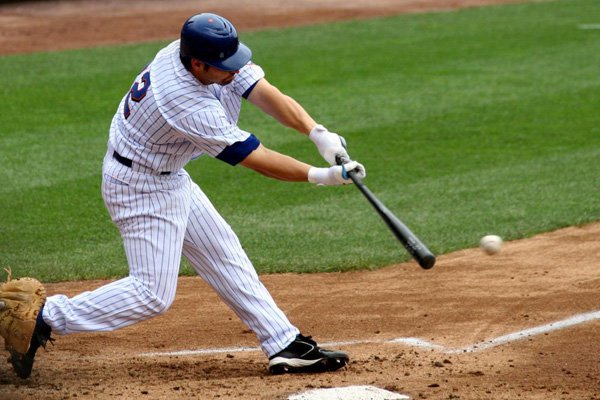In my last article "How to Teach Yourself the Golf Swing", I outlined in detail the steps that are necessary to develop a good golf swing. I also pointed out that, although it takes a good swinging motion to produce good shots, the swing alone does not cause a good result. There are other factors that enter into the equation. This piece will present, and analyze , those factors
The Ball Flight Laws
In order to understand what causes a golf ball to do what it does in flight, you need to know the ball flight laws. With this valuable tool in your tool box, you will be empowered to gain control of how the ball flies when you strike it . First, it will help if you to know that there are only nine ways a ball can flie when struck with a golf club: 1) It can start toward the target, and continue to the target.2)It can start toward the target and turn right of it. 3)It can start toward the target and turn left of it. 4)It can start out right of the target and continue straight right. 5) It can start out right of the target and turn right. 6) It can start out right of the target and turn left. 7) It can start left of the target and continue straight left. 8) It can start left of the target and turn left. 9]It can start left of the target and turn right. It is imperative that I point out here that ball flight has another dimension, trajectory. So how is direction determined? The rule of thumb is thus: the ball will start out traveling in the direction that the club is traveling, then turn in the direction that the eye of the clubface is looking at impact. This condition is the reason why set up is a major determinate of success in the game.How your hands are placed on the club , and your bo and clubface are aligned to the target at address, in relation to the target, is going to dramatically effect the kind of shots you produce. It is imperative that you be vigilant about how you set your clubface, and get your body aligned, in relation to the target . If you are, you will simplify your quest for consistency.
You Need a Routine
I have been real fond of saying throughout my involvment in golf, that the thing I love about golf is, the game always obeys the laws of geometry and physics. We ignore, and break those laws all the time when we play, but the game always remains firmly grounded in them. When I first started to play, I did not want to lend myself to regimentation, and certainly did not pay much attention to detail, but gradually I came to realize that if I persisted in that attitude, I would never play the game to my best potential. So I decided that I would commit myself to follow a routine. What is a routine? A routine, or Standard Operating Procedure( S.O.P. ), is a set procedure that you perform before you attempt each shot. It is a fundamental truth that there are very few things that you have control over in this game, and it is imperative that you be vigilant about controlling anything that is under your control. Having a routine will help you do this. So what are you trying to exert control over? You need to select the proper club for the shot you are hitting. Thus, you must determine the distance from the ball to your target, so that you select the correct club for the distance your shot has to cover.You have to determine the location of the hazards, and take them into consideration, so that you chose the correct target for the situation you face. You want to take into account the elevation, wind condition, and lie, as you select your club and plan your shot. Next , take two or three rehearsal swings to get a feel for the shot you are going to attempt. This part of the routine is the planning phase, and is performed from behind the ball, at a distance of between eight and ten paces. When you have completed the planning phase , you move into the execution phase. The execution phase starts when you begin your walk to the ball.As you walk to the ball, you want to visualize the shot you want to hit. It is important that you set up to every shot in the same manner, and order, every time you approach a golf ball. The reason that this is called a routine is, it needs to become as second nature to you, as walking. We humans have binocular vision, so the best way to approach the ball is to proceed to it from directly behind , because you will get a more accurate view of the target line. Once you identify the target line, aim your clubface so that its' eye looks directly down it. Then arrange your body so that your shoulder, hip, and foot lines run parallel to the target line, adjust your posture, take two or three waggles, take a last look at the target, and pull the trigger.
Your Routine is Intergral Part of Your Practice
I want it to be clear that making your routine an intergral part of your practice sessions is a must. You should never hit a practice shot without going thru your routine.One of the principle reasons so many golfers have difficulty taking their range swings into action on the course is, they fail to make their practice sessions resemble the conditions, and situations they face on the golf course. Therefore, one third of every practice should be devoted to hitting golf shots that immolate those that you may encounter on the golf course. During those sessions you will set the condition for each repetition (distance, lie, wind, type of shot ). Then you go to the bag , pull a club( a driver for the first shot), go thru your routine, set up, and hit the shot. Imagine what your second shot would be, say 150yds. Go to the bag pull the club that you hit 150yds, work your routine, and hit the shot. Work your way thru the bag. You can hit only even numbered clubs in one session, and only odd numbered ones in the next one. You want these sessions to improve your on course performance, so take note of which clubs you are most comfortable hitting, and of those you are not. We all have those we love to hit and those we don't relish pulling from the bag, and don't hit well. The trick to making our games better is to make those clubs into strengths rather than weaknesses. As long as you dread hitting those clubs , they will hamper your development. Mastering those clubs, and your routine will put you on the road to making good shots consistently. On your second shots be sure to drop the ball over your shoulder, and don't improve your lie, because you need to learn to assess lies, and hit shots from every kind of lie. To hit all your practice shots from perfect lies is to stunt your game's growth, and limit the level of skill you will achieve. If you persist in such a practice, you'll find yourself feeling uncomfortable, and lacking confidence, whenever you have to hit a shot from a tight, or bad lie, during your live rounds.
Playing From Uneven Lies
In your play you will be confronted with many difficulties that you must overcome. In your shotmaking some of the most difficult problems will come when you have to hit from lies on slopes [ balls above and below your feet and up and down hill lies]. Very few weekend players ever practice hitting shots from these lies, and without some knowledge, and practice, they can be real score wreckers. Shots hit from these lies, without a thorough understanding of the resulting ball flight, causes shots to go wildly astray. Though these lies warrant your full attention, playing from them when you know how, is not real difficult. With the knowledge of how to play from them, and some practice, you will get a good result. The first thing you must do is to set your body so that it follows the slope. Then swing along tne slope. On balls above the feet, the shot is going to fly right to left, so aim your shot to fly over the high point of the slope. The ball will then fall to the low side at the finish. On balls below your feet, the shot is going to fly left to right. Aim your swing along the slope, and hit your shot to the high point of the slope. Again it will fall to the low point at the end of its flight. Down hill lies will give you the most problem, so be very careful with them. Balance is a major consideration with these, because you are swinging down the slope and your momentum wants to drag you down the slope, so you must set the majority of your weight on your back leg, shorten your backswing, and swing down the slope. The effective loft of your club is going to be reduced, so take a more lofted club for the distance than you ordinarily would. The ball will come out lower, and tend to run a good deal, but that's okay, because you used a weaker lofted club. The shot is going to tend to fly left to right, so aim left an appreciable amount. On up hill lies, the tendancy will be for your body to want to fall backwards, so you must set the majority of your weight on the forward foot. The effective loft of the club is going to be reduced, so select a club with a stronger loft than the one you would normally use for the distance, and be sure to aim the shot right, to compensate for the right to left ball flight the lie will naturally produce.
Clean Contact
Making clean contact on the clubface is a major part of hitting consistently good shots. Good, clean contact is essential to controlling ball flight , and distance. Unless the contact is consistently good, shots will continually be eratic.Two drills will help you to make good, consistent contact. The first is a drill that was a favorite of Harvey Penick.In that drill you practice clipping tees from the ground. Just push tees onto the ground until only the top of the tee is exposed, then use the bottom of the arc to clip it out of the ground. This increasingly makes you more effecient at finding the bottom of the arc. The second drill is one where you place two tees in the ground and hit balls from between them, with the divot occuring just in front of the two tees. If your divots occur before the gate between the tees, you are either attempting to scoop the ball up, or are hanging back on your back side.
Play Practice Rounds
In order to make your development complete you are going to have to fit the work you've done to the golf course. The golf course is where you will test all the hard work, and practice you've done to this point. In addition to being a good test, practice rounds offer the opportunity to correct errors in your swing mechanics, and to analyze your swing faults. Your three objectives in playing practice rounds are: 1] To find out how far you have come in your game development. 2]To discover and correct your swing faults. 3] To become comfortable using the swing, and shot making skills you are developing, under real course conditions. So make maximum use of these rounds. Take lots of practice swings, and follow up bad shots with corrective swings. Always remember that there is a huge difference between a practice round, and a competetive round. In a practice round the hazards are there, and you know that they are there, but the penalty for hitting into them is not great. In a competetive round , where every shot counts, and every ball hit into a hazard exacts a penalty, your performance will be adversely affected by the pressure you feel to avoid a mistake. Your practice rounds, because they give you positive experiences, under simulated conditions, help you to combat, and overcome, the effects of such pressure. A hypothetical situation you may face, would be a hole where you are faced with hitting a drive to a narrow fairway with out of bounds on the right, a sand trap middle right, and water running down the entire left side. A situation like this might cause you to tense up and attempt to steer the ball , rather than take a free, unhibited swing. Remember, it is always preferable to take a positive approach in golf, rather than a negative one. Know this, the golf course architect has placed odstacles at strategic spots on each hole to present you with a challenge, and to give the course a defense against your assault upon it. However, though he wants to challenge you, he doesn't want to discourage you, because he wants you to come back and play again. So he builds fairness into the course by giving you safe landing areas to hit your shots into. It is your job to identify those areas, and direct your shots into them. It is toward that end that we devote so much time and effort, to developing a repeating golf swing, and the skill to consistently hit good shots.
Producing High and Low Shots
No discourse on making consistently good shots would be complete without discussing how to produce high and low shots, because you need these in your arsenal to succeed on the golf course. There are three factors that enter into determining trajectory: 1] Angle of descent. 2] Clubhead speed. 3] Clubface angle at impact. Upright swings[steeper swings], tend to produce higher ball flight. Setting up with more weight on the rear side, and substantially behind the ball, also helps to produce a high shot. Be careful that you don't overdo this, or your swing bottom will 0ccur behind the ball and produce a fat shot. However, it will help you stay behind the ball a bit longer, reduce the shaft lean at impact , and encourage a higher launch angle. Setting up with more weight on the forward side than the rear, helps to promote a low shot, as this tends to keep your weight more centered over the ball, and encourage a flatter swing, with a more forward leaning shaft. High clubhead speed tends to produce a high ball flight, and lower clubhead speed tends to produce low ball flight. With a little thought, and some experimentation, you can begin to put an array of useful shots into your arsenal.The more of such shots you possess, the better player you will be.
In Conclusion
I have thoroughly enjoyed putting this article together, and I hope that it will serve as a good addition to the other articles that I've done; How to Teach Yourself the Golf Swing, and How to Become a Really Good Putter, both of which can be found here on Infobarrel.com. In my next article I will complete the series with an article on the short game and trouble play. Look for it here soon. Until then, I wish you many happy, successful , funfilled days on the golf course.

8 Timesaving Tips to Improve Your Swim

Baseball Game Rules - Baseball Training Equipment - Baseball World Series History

Copyright © www.mycheapnfljerseys.com Outdoor sports All Rights Reserved